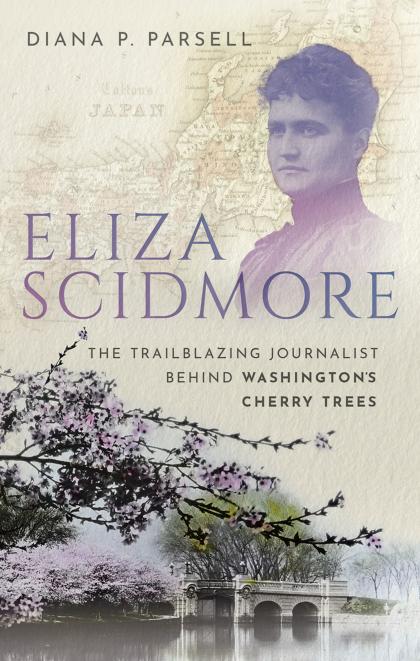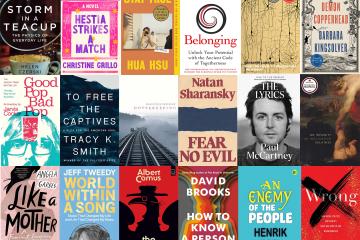After the drab hues of winter, spring bursts forth with floral vibrancy: yellow daffodils, purple hyacinth, red tulips. In Washington, D.C., a single seasonal color dominates. Pink Mania takes over the nation's capital this time of year as all eyes turn to the tidal basin where more than 3,000 Japanese cherry trees burst into bloom, a springtime ritual born in 1912, when the city of Tokyo gave the trees to D.C. Weeks before buds even form, the Bloom Watch begins as arborists and meteorologists try to predict when the explosion of pink will be at its peak. Each year, some 1.5 million people stroll beneath the petalled bowers or participate in celebratory events in the near monthlong National Cherry Blossom Festival.

Image caption: Diana Parsell
Image credit: Lisa Damico
What had been largely lost in all the flowery hoopla is the woman responsible as much as anybody for its happening at all: Eliza Ruhamah Scidmore (1856-1928), a convention-defying, globetrotting travel writer and Japanophile who spent more than two decades working to bring the blooms to the basin. And the woman responsible as much as anybody for bringing Scidmore's story back to the fore is Diana Parsell, A&S '07 (MA), author of Eliza Scidmore: The Trailblazing Journalist Behind Washington's Cherry Trees, published last year by Oxford University Press.
"Scidmore had an adventurous spirit," Parsell says over the phone from her home in the suburban D.C. community of Falls Church, Virginia. "She was a terrific networker and took advantage of opportunities wherever they arose."
Parsell, a journalist and science writer who earned her master's degree in nonfiction writing from the Krieger School's Advanced Academic Programs has lived in the Washington area for more than four decades and has made numerous springtime visits to the cherry trees. Like most bloom peepers, she admits that she initially knew nothing of Scidmore (pronounced with a silent "c" as "sid-more"). Curiously, Parsell first encountered her name far from the Washington waterfront in Jakarta, Indonesia, where her husband's diplomatic work had them living for a time in the 1990s. She brought home a paperback reprint of the 1897 book Java: Garden of the East by one E. R. Scidmore.
Given the 19th-century date, Parsell assumed the author was male. "It was very vivid and made me nostalgic for places I had seen," she says. "When I went online to find out about the author, I was just stunned to learn it was an American woman and that she had written books on Alaska, Japan, China, and India, and had an early association with National Geographic as the first woman on its board in 1892. And then the kicker was that she was widely credited with bringing the cherry trees to D.C." Parsell's writerly alarm bells went off, and she launched a decade-long effort researching and writing about this enigmatic figure—practically camping out at the Library of Congress and undertaking walk-in-her-footsteps treks to Alaska and Japan. She also created a website and blog chronicling her research, which media outlets including The Washington Post discovered, allowing Scidmore's name to begin to get back in the public eye well before the book's 2023 release.
Video credit: Today Show
Iowa-born Scidmore was a child in 1862 when she moved to Washington with her mother—on the rebound from two failed marriages, including a divorce—and older brother George. The tumult of the Civil War was in full swing. She headed back west to attend Ohio's Oberlin College but left after a year. Parsell's research found that Scidmore's half-brother Edward Brooks worked for Washington's National Republican newspaper and surely had a hand in getting his sister her first byline when she was but 19. While nepotism got her foot in the door, Parsell writes that Scidmore's "own personality and enterprise" earned her subsequent assignments, for that publication and many others.
Scidmore once told an interviewer that maps and the globe were her favorite playthings as a girl. That might explain why when most women her age had already settled down into motherhood, Scidmore succumbed to wanderlust. In 1883, the twentysomething scribe headed off to Alaska, where she wrote newspaper articles chronicling a steamboat journey up the Inside Passage and other travels in the vast northern wilderness, purchased from Russia just 16 years earlier. Two years later, Alaska was the subject of the first of an eventual seven travel books. Her entrée to the Far East came in 1885 when Scidmore (and her mother) went to Japan to visit her brother George, who worked for the U.S. Consular Office. Eliza was so smitten with the country she ended up living there on and off. And, of course, it was there she first beheld blooming thickets of cherry trees and witnessed hanami, the seasonal gathering of people to admire the sylvan beauty.

Scidmore returned to D.C. in the late 1880s to find the Army Corps of Engineers hard at work transforming the dowdy mudflats of the city's underutilized waterfront into a proper park. She saw it as the perfect opportunity to bring hanami to America. The men in charge didn't agree. Parsell writes that they were "indifferent and obdurate" to the concept of planting Japanese cherry trees. "They were very conventional in their ideas of what a public park should be and wanted traditional trees, elms, and poplars, and willow trees," Parsell says. Scidmore would continue pushing for the cherries whenever she was in town and not off playing the footloose travel writer. Eventually, her networking prowess paid off. Scidmore was acquainted with Helen Taft and her husband, William Howard Taft, through social encounters in Washington and Japan. When he entered the White House in 1909, Scidmore got the first lady on board with the cherry tree concept. "It turned into this kind of powerful female partnership," Parsell says, and when the Japanese got wind of the first lady's interest through diplomatic channels, the gift of trees was offered.
Alas, the initial gift of 2,000 trees in 1910 arrived here infected with pests and had to be burned. When their healthy replacements arrived two years later, Scidmore was among the dignitaries on hand for a ceremonial planting. But here's the thing: If Scidmore had had nothing to do with D.C.'s beloved trees, her life story would still be bookworthy. Parsell calls her the "Forrest Gump" of her age because she witnessed so much history, such as visiting the Dakota Territories when the Indian Wars were winding down and touring several POW camps during the Russo-Japanese war. She was also friends with the era's luminaries, including John Muir and Alexander Graham Bell. Scidmore's ultimately thrice-married mother might have served as a cautionary tale about the permanence of matrimony and steered her toward a partner-free life of exploration and self-expression. "She had this incredibly enterprising spirit and intellectual curiosity," Parsell says. Distilled down to a single word, she says Scidmore brimmed with "exuberance."
A few years back, a plaque was installed amid D.C.'s cherry tress outlining Scidmore's role in the annual Pink Mania. Scidmore had ultimately left Washington to spend her last few years in Switzerland, where she died in 1928. Her ashes were taken to Yokohama, Japan, and to the cemetery where her mother and brother are buried. A cherry tree shades the family plot and a plaque next to the headstone bears an inscription in Japanese, which translates to "A lady who loved Japanese cherry blossoms rests here in peace."
Posted in Arts+Culture, Alumni
Tagged alumni, books, krieger school









